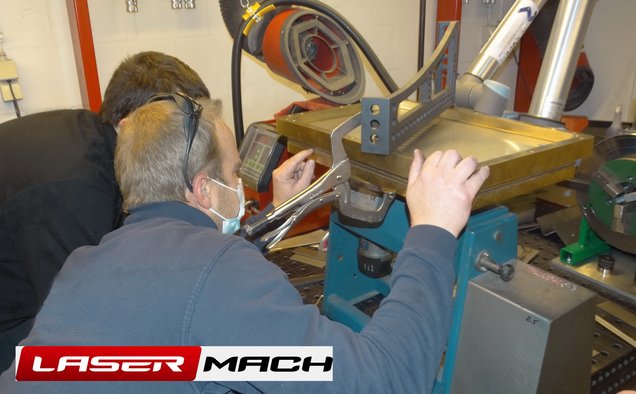Plate Heat Exchanger
Thin wall laserwelding: a piece of cake for wobble+
Sample Welding : Laser Welding of pillow plate : 0.8 mm stainless on 6 mm stainless steel welding with wobble laser
In the heat transfer market, most experts are familiar with plate heat exchangers or PHE's. Initially introduced for hygiene purposes for the dairy industry and subsequently developed in a variety of uses, they consist of several parallel plates. The plates are corrugated to increase turbulence, exchange surface and give them a certain mechanical rigidity. In addition PHEs have flow passages for flow of fluids at the corners, and the plates have gaskets to control flow and prevent leakage. The corrugated plates are combined to create complex channels through which a hot and cold fluid are distributed. The two fluids flow inside the exchanger in the passages between the plates; this without mixing on either side of the corrugated plate. Energy is thus transferred from one to the other as they flow side by side without touching each other.
There is a special type of plate heat exchanger for the condensation of halogenated refrigerant fluids called “brazed plate heat exchanger”. The brazed plate heat exchanger has the characteristic of being a stainless steel plate heat exchanger where the gaskets are absent. It is assembled using a special vacuum furnace brazing technology, which makes it possible to create a very compact, durable and highly reliable unit. Brazing spots hold the various plates together, and the heat exchanger is tightly fixed. Now with our Wobble technology we can replace all complex and expensive brazing by simple laser welding, which goes much faster, cost much less and is more rigid.
In fact, while the various Brazed PHE plates are still slightly movable and not so resistant, the Wobble+ laser welded PHE's have strongly welded plates together, eliminating any mobility, which makes it more efficient, reliable and economical, reducing costs in the long run. The Brazed plate Heat Exchanger is mostly made of copper or nickel: in this case, with these materials, the heat exchanger will work with all refrigerants except ammonia. For ammonia, we will have BPHEs with stronger metal alloys like stainless and laser welded channels alternating with those with a gasket. The refrigerant flows through the welded channels, and is in contact with the gaskets in the circular holes.

Plate heat exchangers, often called plate-and-frame heat exchanger, have a major advantage over (high heat transfer rate) other types of heat exchangers in that the fluids are exposed to a much larger surface area.
The plate heat exchanger consists of a frame with end plates which squeeze the corrugated heat transfer plates. Within plate heat exchangers, the fluid paths alternate between plates allowing the two fluids to interact(heat or cool one fluid by transferring heat between it and another fluid, but not mix).
- Plate Heat Exchangers have various applications-
- petrochemical
- pharmaceutical
- power
- industrial dairy
- chemical
- food and beverage industry
Types of Plate Heat Exchangers
There are four main types of plate heat exchanger
- Brazed Plate Heat Exchanger
- Gasketed Plate Heat Exchanger
- Welded Plate Heat Exchanger
- Semi-Welded Plate Heat Exchanger
Gasketed Plate Heat Exchangers
High quality gaskets are designed to protect against leaks and seal plates together. Plates can easily be removed for expansion, cleaning, or replacing purposes. These design can drastically reduce the costs of maintenance.
- Typical applications of Gasketed Plate Heat Exchanger
- Oil cooling
- Heat transfer fluids
- Hazardous liquids
- Process chemicals
Semi-Welded Plate Heat Exchangers
A mixture of welded and gasketed plates. This type of heat exchanger contain pairs of two plates welded together which are gasketed to other pairs, therefore one fluid path is welded and the other fluid path is gasketed. It's easy to service on one side and able to transfer more intense fluids on the other. Semi-Welded heat exchanger type is perfect choice for transferring expensive materials because it has a very low risk of fluid loss.
- Typical applications of Semi-Welded Plate Heat Exchanger
- Heat transfer fluids
- Oil cooling
- Process chemicals
- Hazardous liquids

